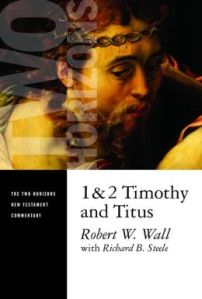 Robert W. Wall with Richard B. Steele
Robert W. Wall with Richard B. Steele
1 & 2 Timothy and Titus.
Two Horizons New Testament Commentary.
Eds. Joel B. Green and Max Turner.
Grand Rapids, MI: Eerdmans, 2012.
Available at Amazom.com.
In this commentary, Robert Wall offers a canonical approach to the pastoral epistles (PE), interpreting them in light of the regula fidei, while Richard Steele offers historical case studies that instantiate key themes of the PE in the early church.
I have to say that I’ve read, enjoyed, and learned from several PE commentaries, esp. Phil Towner and I. Howard Marshall, and others. However, Robert Wall’s commentary in an absolute gem because he seeks to read the PE in tandem with a wider array of literature like Acts and the Rule of Faith, which is genuinely illuminating.
Walls affirms historical critical exegesis but adds that “exegesis of the literal or plain sense of Scripture is foundational for scriptural interpretation, but has value only in relationship to a more holistic end” (3). On purpose he says, “[T]he Pastoral Epistles are deeply concerned about the redemption of outsiders – those who live outside the sacred household – while recognizing that Christians confession and practice are inherently marginal” (12). While Wall accepts Pauline authorship of the PE, nonetheless, he adds that, “the Pastoral Epistles may have been added to complete the Pauline corpus in a way that settles this intramural debate among rival Christian groups over the identity of the canonical Paul” (22).
On 1 Tim 2:12-15, Wall warns that we should “resist treating it in isolation from other canonical texts” (86-87). Wall maintains that “this passage’s definition of the ideal Christian woman is that she influences others by her prudent choices rather than by her instruction” (93). On Tit 3:5, Wall comments: “Grace breaks into human existence to save sinners from total lawlessness because of the epiphany of a good and friendly Benefactor, not because of humanity’s religious and moral performances” (361). The theological interpretation sections are largely drawn from the categories of the regula fidei. Richard Steele also provide three case studies on how the key texts have been received in the Methodist tradition. All in all, a good commentary, clearly something different to the usual, very insightful, a pleasure to read.











